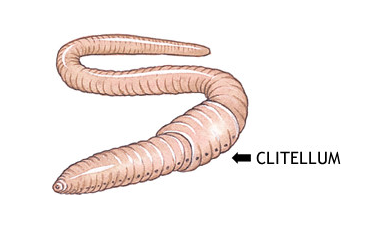Reproduction
Curious about the Life of a Redworm?
They eat, lay eggs and produce waste. Eventually, they die and become a part of the compost themselves.
General Information:
A pound of redworms will average 1000 redworms, but can range from 500 to 15,000 depending on their size. Don't be fooled if your supplier advertises 1 lb of soil with redworms and claim to have at least 500 redworms. It's not likely, ask if they guarantee 1 lb of redworms.
Redworms digest 1/2 their body weight every day (That means if you start with 1 lb of redworms they need 3 1/2 lbs per week), young growing redworms will eat more, just like kids.
Breeding:
Breeding Ring - Clitellum
Redworms reach breeding age in 9 - 12 weeks. Mature worms will grow a breeding ring, called a clitellum, a third of the way down their body.
An adult redworm can lay one egg capsule a week which contains, on average, 3 worms.
Egg capsules hatch in approximately 21 days under optimal conditions.
Newer egg capsules will be yellow. As they mature, they will shift to red. A dark red capsule is indicative of hatching.
A single capsule contains 2-12 redworm eggs, with an average of 2 to 4 red worms hatching.
A single redworm reproduce to over 49,550 in a single year:
This does not include the unhatched egg capsules at the end of the year.
Environment:
Redworms will survive in compost temperatures of 32-95 degrees. Higher or lower temps are possible in your compost, but that is not usually an even temperature through the whole bin. Redworms just need enough compost area to get away from the extreme temp. Outside temps are different see climate zones.
When starting your bin your red worms may wander. This is due to the new environment; it may not taste the same. Make sure there is food (fruit, vegetables or some type of green). Bedding alone (leaves, sawdust, or newspaper) has no immediate food value and they may wander. Keep a light on until they get used to their new home. This can take 30 minutes to a couple days. I encourage new composters to find some older compost that includes some working organisms so your redworms will feel at home quickly.
Redworm bedding is shredded newspaper, shredded leaves, sawdust, cardboard, or other brown material. It is good to have some damp bedding in your compost along with your food waste. I recommend shredded leaves or aged sawdust since they do not compact like newspaper.
Redworms do not like vibrations - If your redworms are continuously migrating out of your bin this may be the problem.
Redworm Kryptonite: Dry sawdust or peat moss. Redworms breath through their skin if they are surrounded by only dry material they will secrete their internal moisture to breath as long as they can. This information is mainly for harvesting your redworms. When you put them in a pile on a table to separate the castings, you can surround your pile with some dry peat moss and they will not wander from the pile (that is as long as you also have a light above them).
Redworms Favorite Food: Watermelon and they don't mind if you eat the good part first. Actually any kind of melon, squash (to include pumpkins), or soft garden vegetable.

